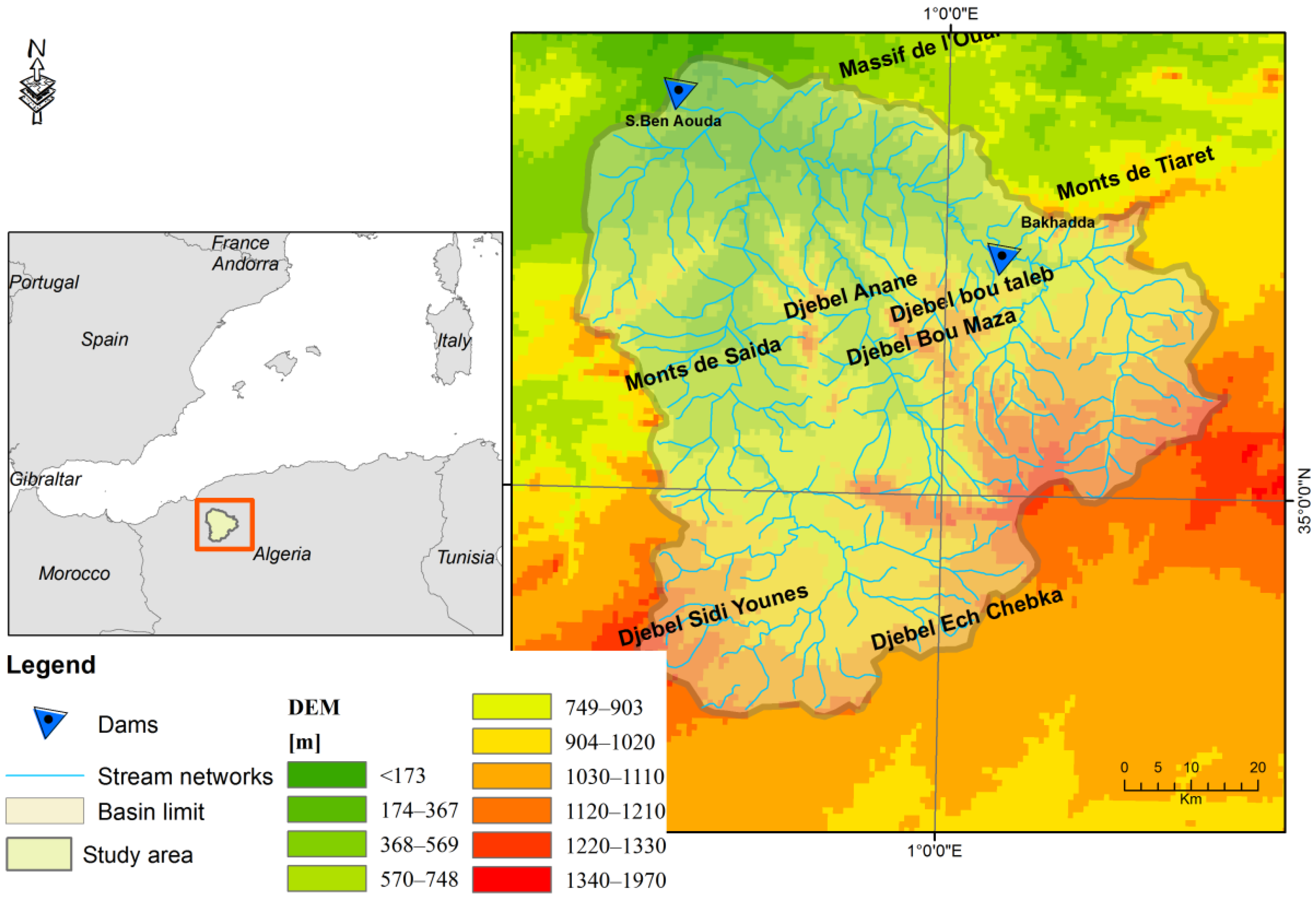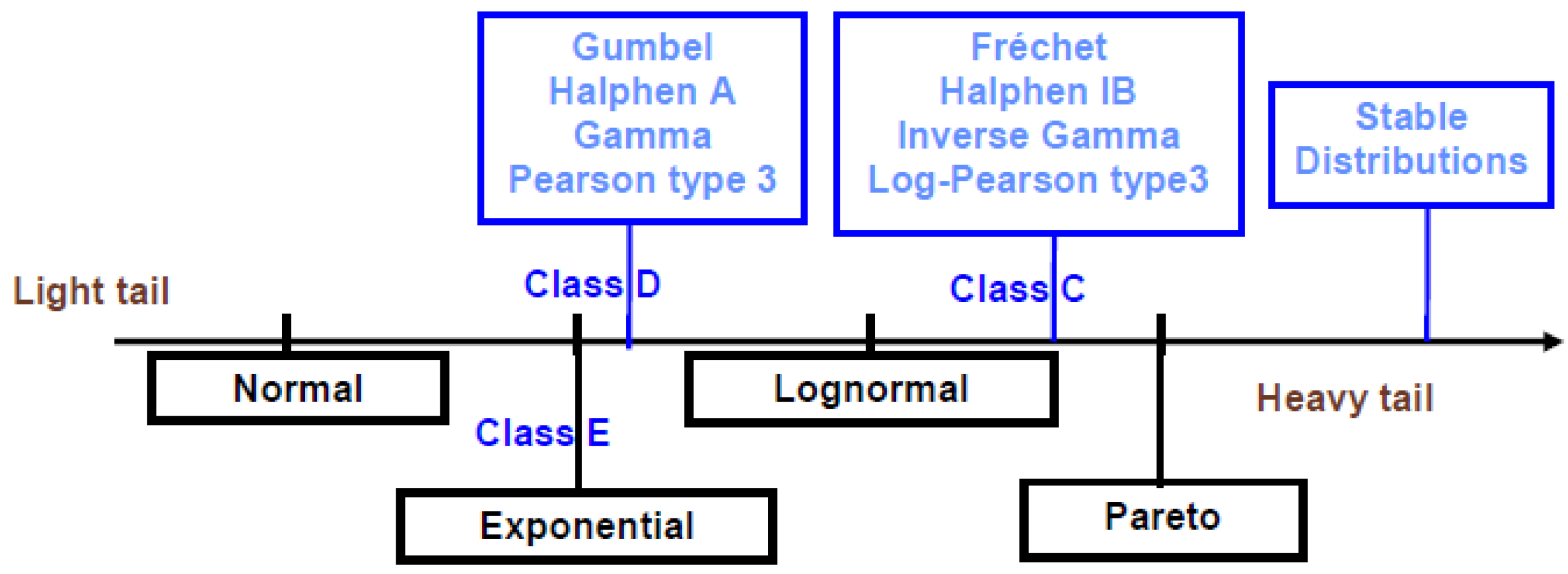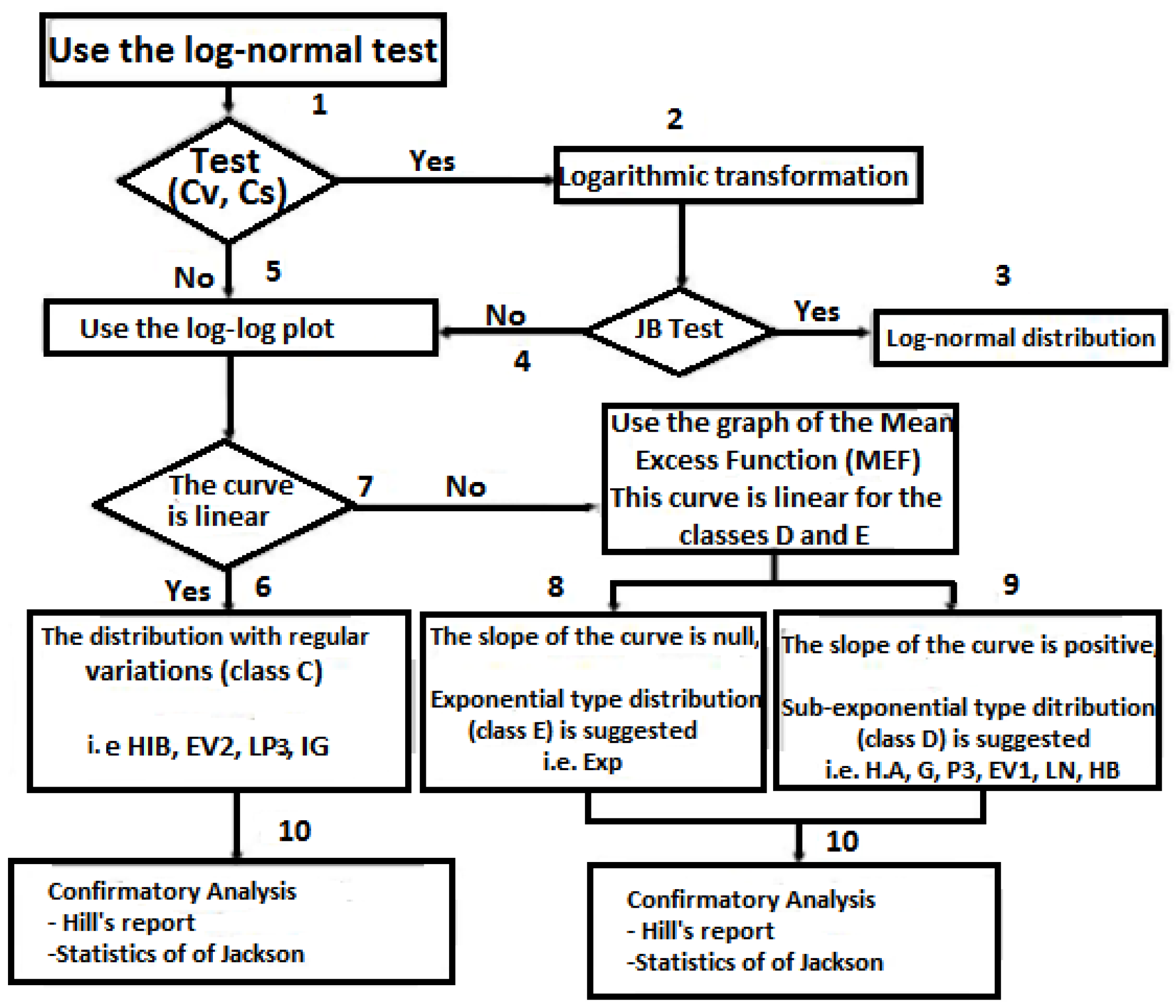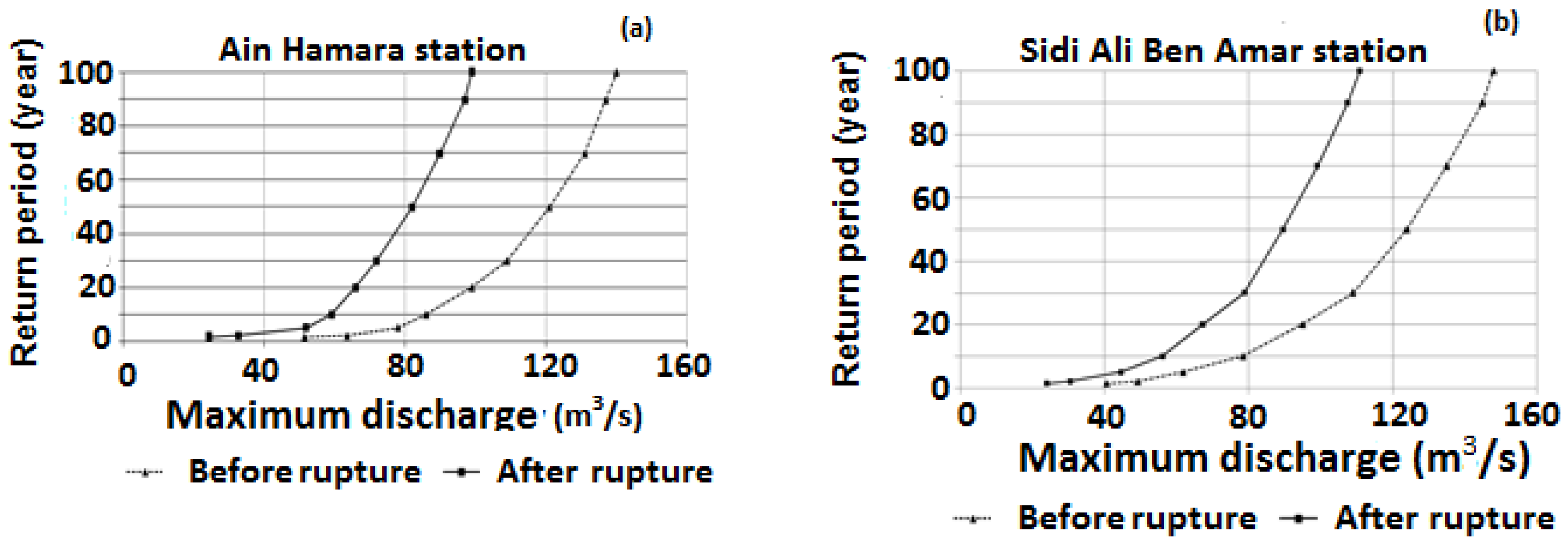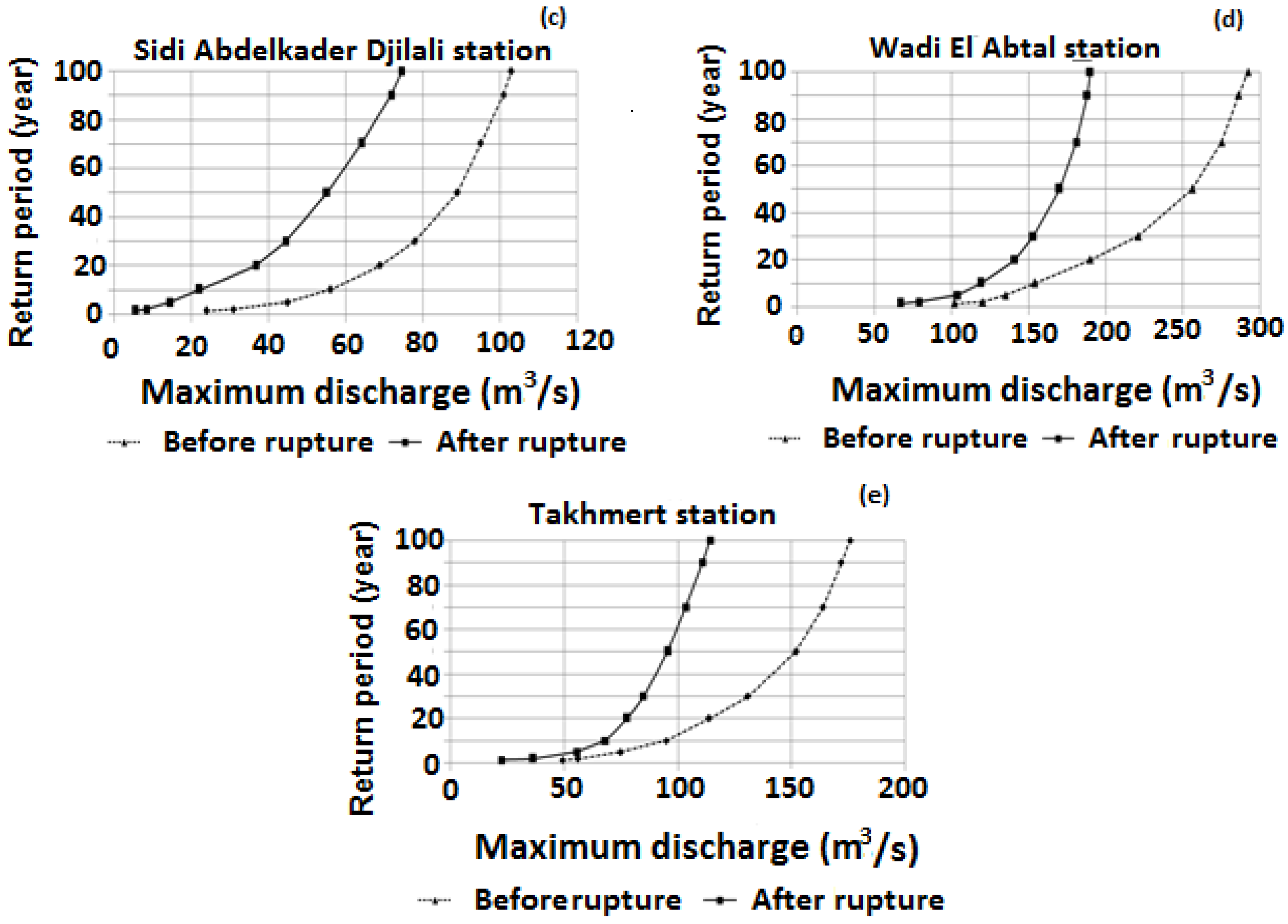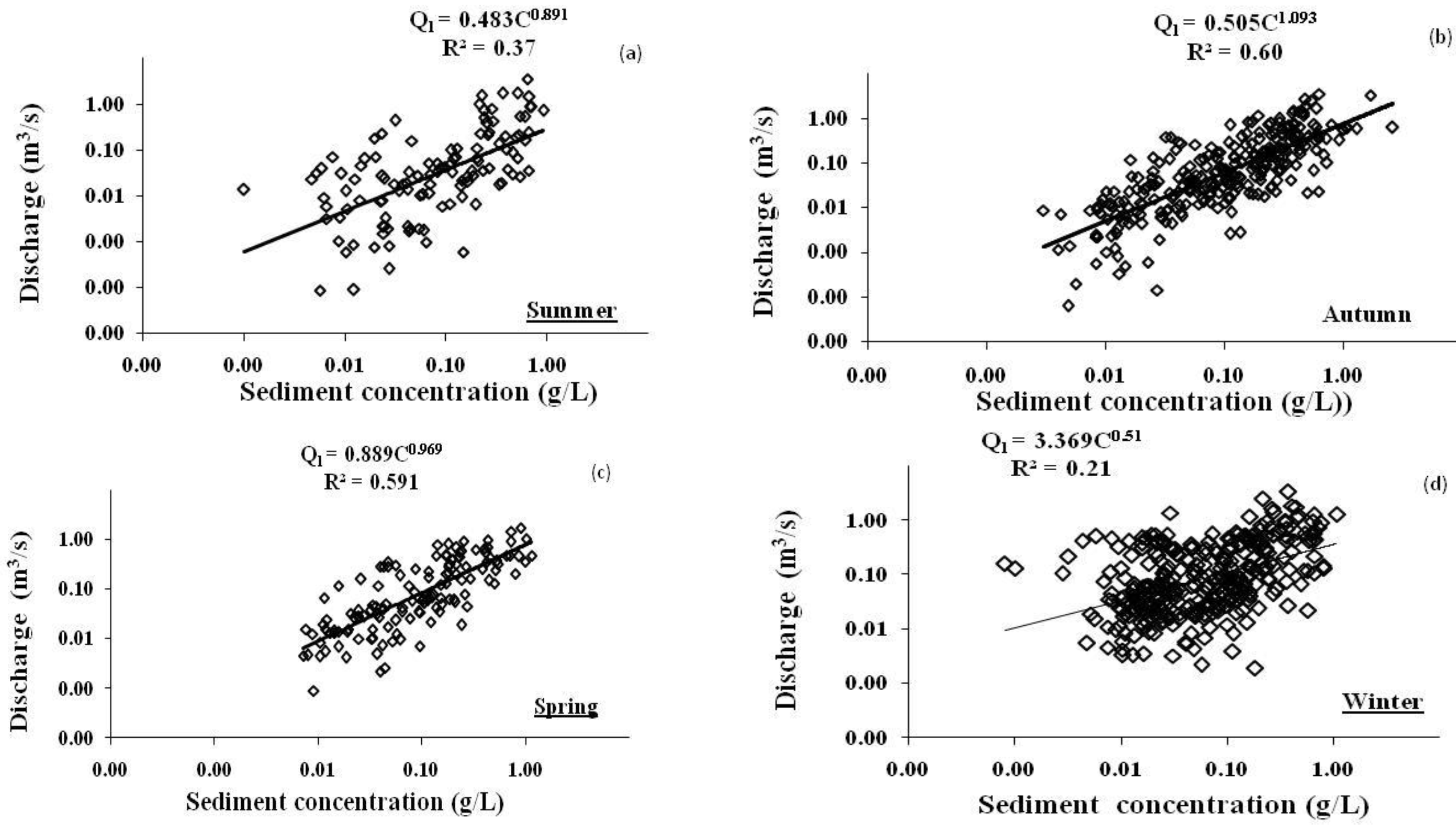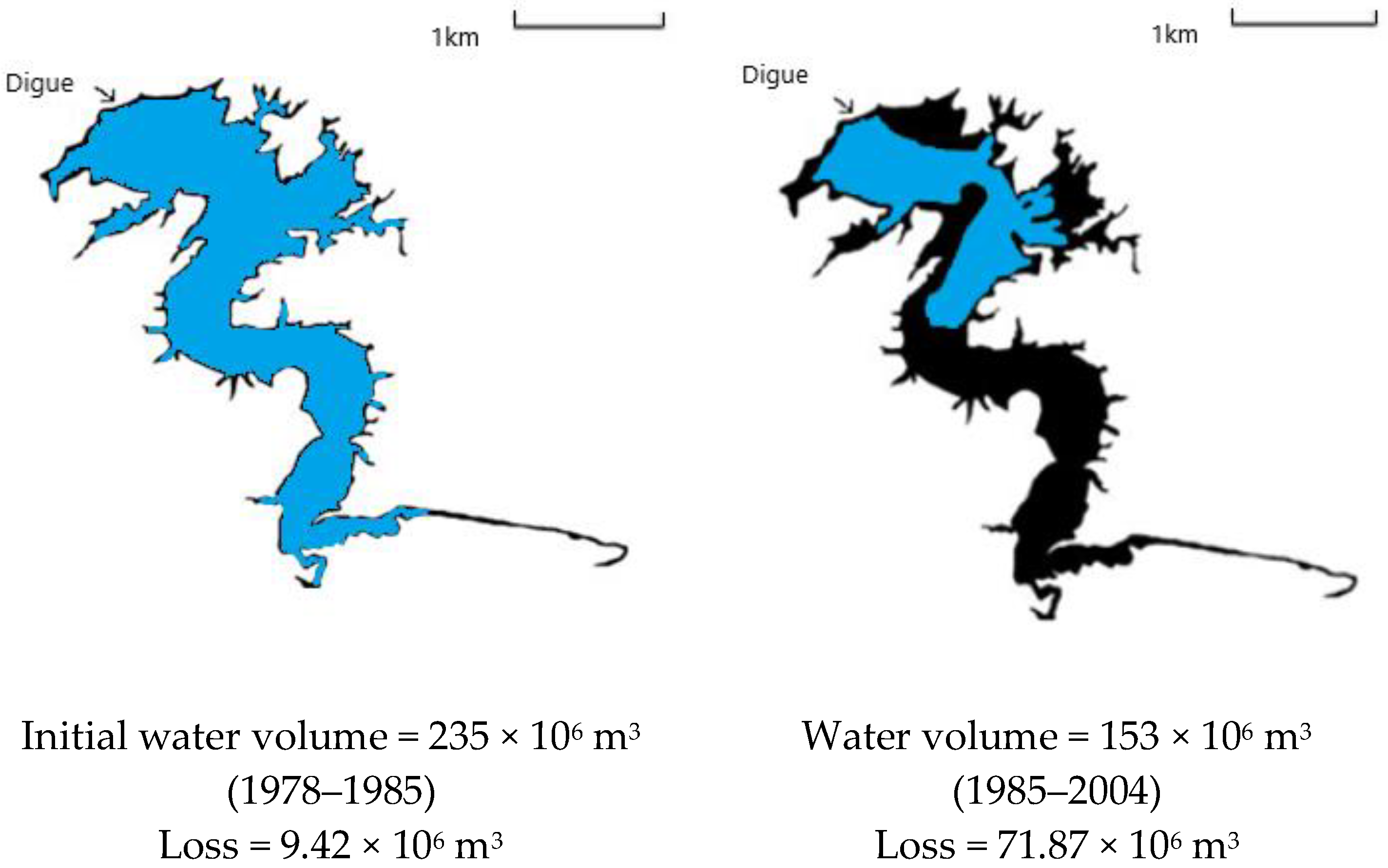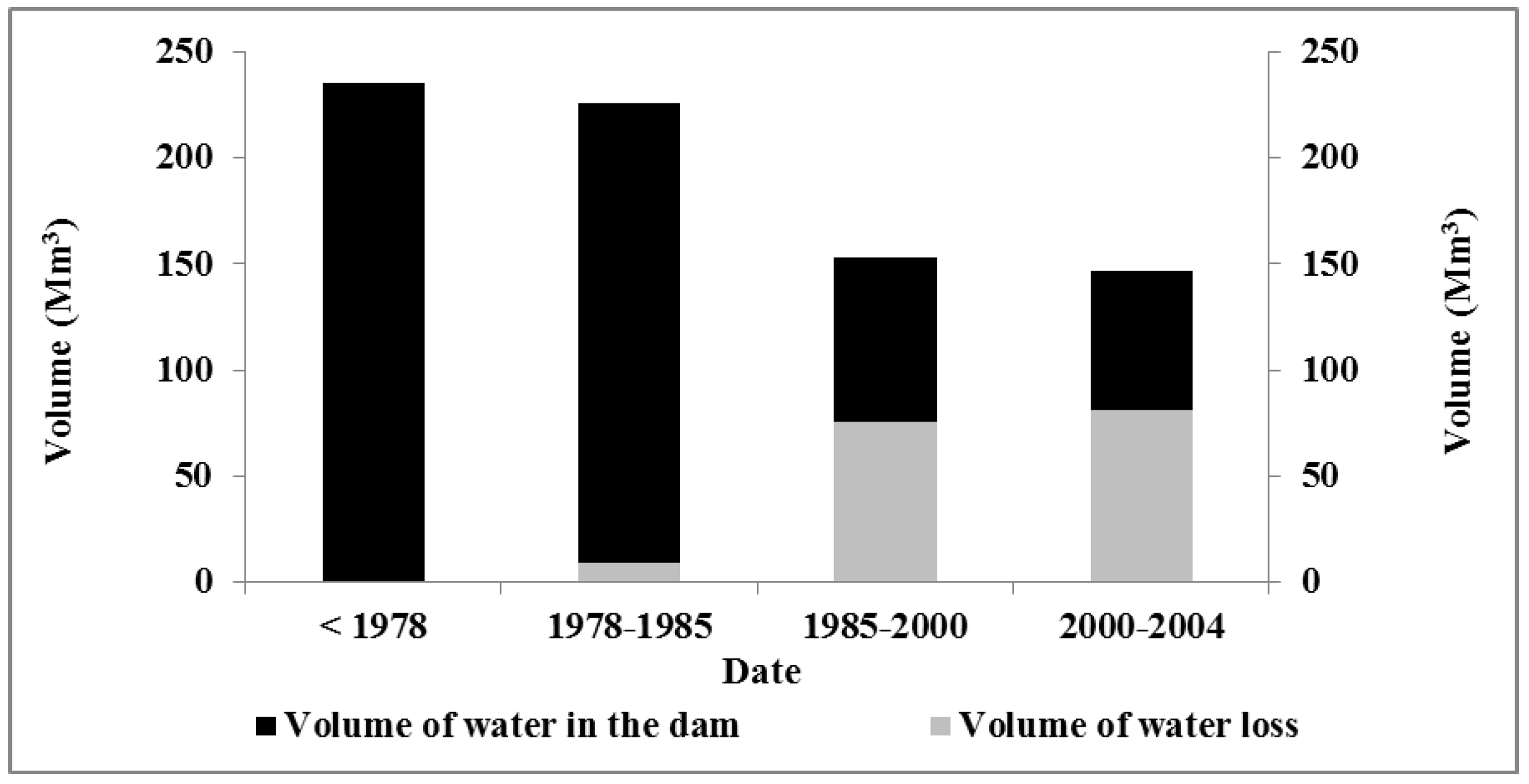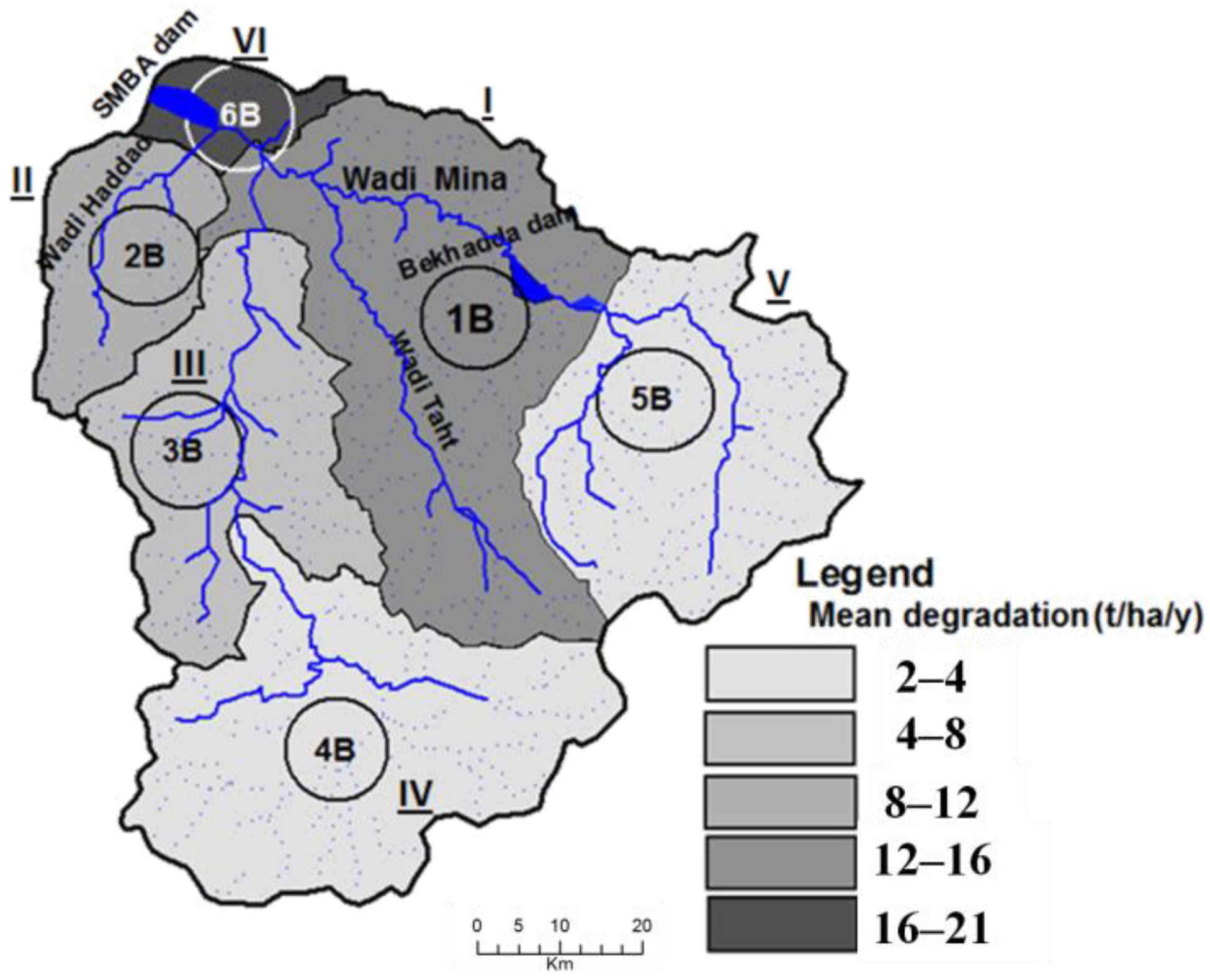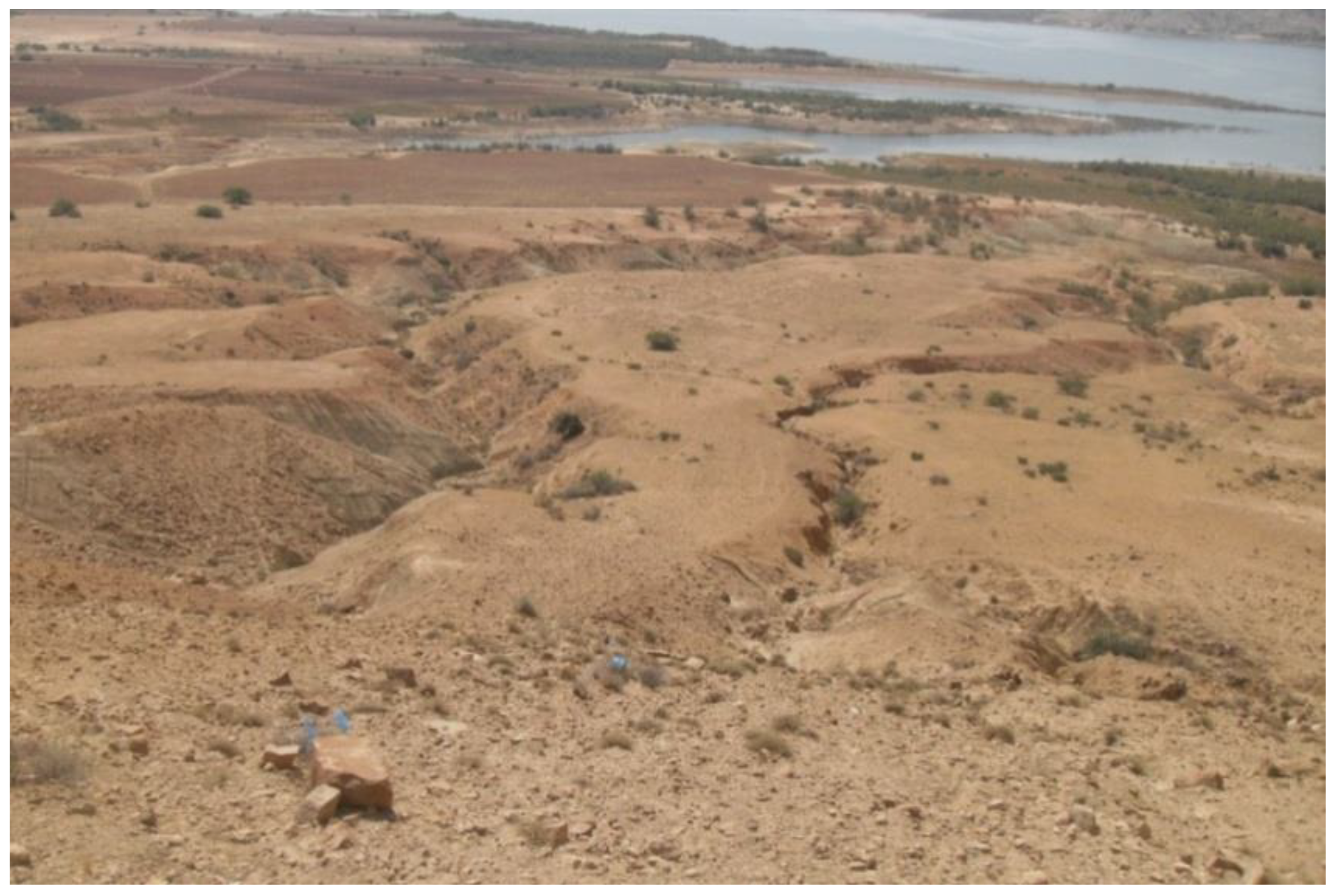3.1. Analysis of Precipitations
At the monthly scale, some significant patterns arise. There are two periods of maximum occurrence of rupture in the rainfall time series of the stations studied, Autumn until January, which concentrate more than 40% of the annual amount of precipitation, with a peak in December and January, and Spring between April and June with more than 20% of the annual amount and two peaks in June and April. Intermediate seasons show much less occurrences of ruptures during the 1970s. However, during the 1980s the maximum of occurrence of ruptures is in August, and similarly during the 2000s in August and September, while during the 1990s the maximum is in March (
Table 3).
The pluviometric posts for which a rupture could be detected are more numerous in the north than in the south. The pluviometric deficits noted are frequently close to 19–20%. This pluviometric deficit is thus felt for more than three decades and seems to be accentuated during the 1970–1980 decade. The areas in the west center and northwest have higher totals ruptures than the other areas on a monthly and yearly scales.
Indeed, 13 stations present a considerable rupture during the 1970–1980 decade for the entire catchment area of Wadi Mina, which represents 50% of the pluviometric stations used in this study (
Figure 5).
It is equally interesting to note that the stations that present ruptures are localized differently during each decade: in the northwest of the basin before the 1970 decade, on the entire basin, except for the highlands of south and southeast, between the years 1970 and 1980, and on the entire basin, except for the center, after 1980, but in proportion representing less than half.
Indeed, we have noted a rupture corresponding to a decrease of precipitations during the mid-1970s over the whole Wadi Mina basin (58% series present a rupture in 1976) (
Table 3), date presented by numerous researchers [
6,
104], who already indicated the tendency towards drought starting with 1970 in north Algeria. These results are compliant with the recent works in Algeria [
8,
11] and which concluded to a rains decrease noted during the last thirty years which hit the entire country of Algeria, but especially its western part, adding up to: (a) 30–40% at annual level and more than 40% during winter and spring in the Mascara region; (b) 20–30% on the littoral, starting from the center to the western part of the country; and (c) 20% at annual level and 25% during winter in the center of the country. They confirm as well the results of works carried out on the basins of the extreme west in Algeria [
6,
11] which concluded to a decrease of rainfall. A rupture in the rainfall time series is frequently observed in 1979–1980, except 1972 for the Wadi Mina basin, at the Wadi El Abtal and Ain Hamara stations, and 1976 for the west-central part of Algeria. These results confirm as well the occurrence in Morocco of a pluviometric deficit starting with 1970 and its continuation during the 1980s, an extremely severe and long drought episode [
105]. At the level of North Africa, the results obtained by Meddi et al. [
11] in Algeria and by Bouzaiane and Laforgue [
106] in Tunisia indicate the same rupture period and show the spatial extension of the drought, accompanied by a net pluviometric reduction. The conclusions of the Intergovernmental group on the climate evolution from 2001 and 2007 [
107] and those of the regional report of the United Nations on the changes in North Africa [
108], go in the same direction.
3.2. Analysis of Hydrological Data
The discharges register a global decrease since 1970 (
Table 4), or the probable ruptures are noted as well during rainy season and dry season (
Table 4), which means that even the low water levels are slow, for a sudden drop, it indicates that the level of the groundwater has also abruptly fall.
At annual level, the probable rupture dates are 1974, 1975, 1980 and 1994, which corresponds generally to the ruptures detected at month level. In addition, the ruptures on the series of annual daily maximum were for the most part noted in 1970, 1984 and 1995 and the ruptures dates for the annual daily minimum series are detected in 1972, 1981 and 1994. The rupture in the daily maximum flows series is thus never noted the same year as in the average annual flows series, while there are the same ruptures dates for the average annual flows and the minimum daily flows.
In Sahelian and non-Sahelian Africa, many authors have revealed, based on hydro-pluviometric series, a dry phase which started around 1970 [
109,
110] and which lasts until today [
111,
112], it was noted as well a decrease of rivers flows [
109,
113,
114], lakes levels [
113], as well as a shortening of the rainy season [
115,
116].
These results indicate a satisfactory concordance with the dates detected on the annual and monthly rainfall of late 1970s/early 1980s. We thus assume that the decrease of runoff would be caused by a global decrease in precipitations on the catchment area of Wadi Mina [
47]. However, we must not rule out a possible impact of storages and uses on the drastic decline of low water levels compared to groundwater.
In addition, several authors, among which [
117], have as well reported rain decreases for the Mediterranean perimeter: in Spain, Italy, Turkey and Cyprus from 1951 to 1995 [
118], between 1950 and 2000 in October in Mediterranean Iberia, March in Atlantic Iberia, January and winter in Greece and winter in the Middle East. Hulme et al. [
119] showed a strong decrease of rains for the Mediterranean basin between the start and the end of 20th century. Likewise, subsequent to an analysis of the evolution of pluviometric inputs in the plains of Ghriss (northwest Algeria) [
10], it was shown a net decrease starting with 1973, estimated at more than 25%. We can quote as well other results that have indicated that rains simulation over north Algeria, with an annual decrease of 15%, would entail a reduction of the annual runoff of 40% [
120]. In Morocco, a climatic rupture that starts around 1976 in certain regions and which extends largely around 1979–1980, to nearly the entire territory, was noted [
69,
121].
As a consequence of the decrease of rainfall after the 1970s rupture which was observed in most basins of western Algeria, river discharges generally decreased as well. Meddi and Hubert [
6] showed that the decrease in river discharge varied between −37% and −70% from eastern Algeria to western Algeria. In the Macta basin in northwest Algeria, runoff was estimated to be 28–36% lower in 1976–2002 as compared to 1949–1976 [
11]. In the Tafna basin, also in northwest Algeria, research [
122,
123] showed that the decrease in precipitation after the rupture date was, on average, 29% over the whole basin and was accompanied by a decrease of 60% in river flow [
42]. In Wadi Sebdou in west Algeria, Norrant and Douguédroit [
118] showed that rainfall and discharge began to decrease in the 1970s. The diminution of rainfall by 24% between the period 1939–1975 (526 mm) and the period 1975–2004 (401 mm) induced a decrease by 55% of the yearly volume discharged in 1975–2004 as compared to 1939–1975. A similar variability was observed on Wadi Abd basin (Wadi Mina) [
43].
Finally, we note that annual discharges have been decreasing overall since the 1970s, which generally corresponds to ruptures detected at the monthly time step. There is therefore a good agreement with the rupture dates in the annual rainfall series, which suggests a climatic cause, in the first place, the observed decline in discharges in the Wadi Mina basin [
47].
The study of floods is a precondition for the choice of an adjustment distribution and thus the floods flows on the entire Wadi Mina basin are classified in category C and follow a GEV distribution (
Table 5).
The results of stationary nature and independence hypotheses tests of the studied data concerning the annual floods of the stations of the sub-basins of Wadi Mina indicate the acceptance of the independence tests of Wald–Wolfowitz and the stationary nature tests of Kendall for all the stations (
Table 5).
The study of the floods recurrence variability before and after the ruptures was performed on all the stations of the basin of Wadi Mina (
Figure 6). For all the stations, the maximum discharges values decreased for the same return period with about 30 to 40%. For example, at the Ain Hamara station and before the rupture of 1992, the floods with intensity lower than 80 m
3·s
−1 only return once in five years (
Figure 6a). However, beyond this value, precisely starting with 99 m
3·s
−1, the floods present longer return periods (20–100 years). However, after the same rupture date and for the same return periods, the intensities of the floods considerably decreased. For example, with a return period of 20 years before 1992, the flood with an intensity of 99 m
3·s
−1 became centenary.
The change of the pluviometric regime of the 1970s had thus as an impact a variance of recurrence of floods on all the sub-basins of the catchment area of Wadi Mina.
The pluviometry reduction has, of course, consequences on the watercourses regimes and thus on the availability of water resources which is the key to the success of many development projects. Nevertheless, the consequences of this reduction of flown volumes are already obvious with regard to the water and environment resources exploitation. Agriculture and the alimentation of impoundments are largely sanctioned by this resource decrease. The consequences of this phenomenon are thus very worrying with regard to the good functioning and the cost-effectiveness of projects already performed or planned.
3.3. Solids and Liquids Annual Transports
The annual average concentrations of SPM are compared with annual average discharge (
Figure 7). Despite year-to-year irregularities at the Sidi Aek Djilali station, concentrations and discharges have changed in opposite directions. Discharges increased from 14 m
3·s
−1 in the late 1980s to less than 3 m
3·s
−1 in the early 2000s, while concentrations increased from 44 g·L
−1 in 1974 to nearly 78 g. In 2005, flows at the El Abtal Wadi station increased from more than 40 m
3·s
−1 in 1974 to 0.48 m
3·s
−1 in 1997, whereas the concentrations evolved by 12 g·L
−1, in 1971, to almost more than 67 g·L
−1 in 2005. However, ruptures were detected on the rainfall and discharges from the mid-1970s, but this result show that is no effect of ruptures in precipitation and discharge on the solid load response since the discharge and rainfall decrease in the 1970s and increase in the early 2000s while the sediment load is still increasing. Geomorphologists have noted the difficulty of predicting the impacts of climate change on sediment yield due to nonlinear effects [
124,
125,
126]. In addition, Achite and Ouillon [
42] in their study on Wadi Abd basin, found that the change in flow regime induced a fully nonlinear effect between river discharge and sediment yield. This must be considered in the forecasts, especially in small river basins in semi-arid areas.
Regression analysis was performed between the concentration in instant suspended sediment (c) and the instant discharge (Q) at Wadi Mina. Generally, the power model Q = aC
b, where a and b are regression coefficients, is the most used for the estimation of the sediment concentration (
Figure 8) [
77,
78,
79].
As for the majority of watercourses, we found a power relation [
127] for Wadi Mina, connecting the concentration of SPM in g·L
−1 to the liquid discharge in m
3·s
−1 (
Figure 8). A first graphic analysis of this figure shows a fairly strong dispersion around the regression line, with a very broad concentration range for low discharges below 10 m
3·s
−1 and concentrations that become significantly higher, above 10 g·L
−1 for discharges greater than 50 m
3·s
−1.
For studying the basin responses in terms of discharges and SPM during the hydrological year, it was considered useful to regroup the instantaneous values pursuant to the different seasons (
Table 6).
The analysis in
Figure 9 shows that autumn and spring are distinguished by their strong liquid discharges generating an important flow of SPM. The maximum solid flow is of 42,365 kg·s
−1, achieved in September 1994, resulting from a liquid discharge of more than 351 m
3·s
−1.
In contrast, during winter and summer, we note a net regression of liquid discharge that do no longer exceed 84 m3·s−1 in winter and 38 m3·s−1 in summer. However, we note a few specificities for each season.
For autumn, the heavy charge is explained by the fact that rain often falls on a dried up soil and badly protected by vegetation [
68].
The basin of Wadi Mina is bare in autumn and, after a long warm period, the autumn floods imply systematically suspended solids inputs in maximum number and this phenomenon is relatively reduced for the following season, in winter or when the lands forming the basin are saturated and the vegetation cover is developed [
68].
On the one hand, the torrential and aggressive rains are the ones occurring in October and November and they tear off major quantities of SPM and, on the other hand, the weak vegetation cover of the preceding season (summer) favors the destruction of the soil aggregates that shall be subsequently transported in suspension by the watercourse.
In winter, the erosion of the bed and the banks along the watercourse becomes important because of the increase of discharges in Wadi, and as well runoffs are generated by rainy sequences which are relatively abundant but of weak intensity (0.4 mm) in Takhmert and (29.1 mm) in Ain Hamara. They find a loose soil with vegetation cover that confers soil roughness and favors water retention [
128].
In winter, the runoffs remain important, although this season is a little rainy and cold transition period with a succession of freezing and thawing which is caused essentially by the important water reserves, stored in the soil, following the autumn rains.
In spring, the erosion of the bed and the banks along the watercourse becomes important as this is essentially related to the increase discharges in the Wadi and the herbaceous cover and cultures that considerably reduce the mobilization of thin materials on the slopes. We can add as well the reduction of rains of heavy intensity compared with the winter season.
At the end of spring, the soil is humid and the vegetation cover is well developed. On the slopes, the thin soils saturate rapidly and develop important erosion in the gully and mass movement [
129,
130]. In addition, in this period, the floods have an important role in the production of sediments in the drainage networks. In addition, Hallouz et al. [
67], in their study on the Wadi Mina basin, found that the maximum values of the solid inputs, for all the sub-basins, are observed at the beginning of autumn and at the end of the spring, this variability is explained on the one hand by the variation of the vegetal cover (bare soils) during the year and the erosive nature of the autumn rains (high intensities) and on the other hand by the releases made by the Bakhadda Dam, so these two factors allow the first autumn floods to transport large quantities of sediment after a long dry season characterized by high temperatures and the destruction of soil aggregates. Rainfall erosivity is the potential ability of rainfall to cause soil loss [
131]. The rainfall erosivity index represents the climate influence on water related soil erosion [
132]. Rainfall erosivity is the impact of the kinetic energy of raindrops on soil. Higher velocity and larger size of the raindrops results in higher kinetic energy and higher soil loss. According to Yu [
132], most soil erosion researchers and soil conservationists recognize the positive correlation between erosivity and rainfall intensity [
133].
3.5. Where from Does Originate the Sediments of the Dam?
Thus, the results of bathymetric surveys performed at the level of the SMBA Dam indicated that the capacity loss of the dam since its commissioning in 1978 and until 2004 is evaluated at 82 × 10
6 m
3 (
Figure 10), equivalent to a third (1/3) of its initial capacity. Remini and Bensafia [
64] estimated that, in 2010, the SMBA Dam registers a sediment volume equal to 109 × 10
6 m
3, namely an annual average loss of about 3.5 × 10
6 m
3·year
−1, equivalent to a sediment load equal to 5.6 × 10
6 t·year
−1 that deposits in the impoundment of the dam (considering an average density of the sediment of 1.6 t·m
−3).
Indeed, according to bathymetric surveys conducted in 1978, 1985, 2000 and 2004, the SMBA Dam has lost much of its capacity (
Figure 11), from 1978 to 1985 annual loss estimated to 1.35 million m
3, from 1985 to 2000, an annual loss of about 4.41 million m
3 and from 2000 to 2004 an annual loss was estimated to 1.42 × 10
6 m
3, over all these periods of bathymetric measurements, the highest loss rate was observed between 1985 and 2000, which is probably due to exceptional rains that hit the region during this period, thus in October 1993: “Twenty minutes of rain do 16 dead and a dozen of missing persons in Relizane” [
137].
It is important to note that at the start of the dam exploitation, the reservoir filling with fine particles is carried out linearly according to weather conditions. Starting with 2000, there was a decrease in siltation, mainly caused by the dam exploitation mode (periodic shelving of fine particles by the outlet gates) [
14].
Conversely, the calculations made by the concentration measures for the basin of Wadi Mina at the level of the station of Wadi El Abtal and Wadi Haddad, at the Sidi AEK Djilali station level, and which control a surface of 5856 km
2, generated a load equal to 5.2 × 10
6 t·year
−1 (
Table 8). The difference of 400,000 t·year
−1 corresponds to the sedimentary inputs of the micro-basin surrounding the impoundment (192 km
2) and the autochthon sedimentation in the impoundment, without being able to establish the parts of each source. To elaborate further on this topic, we should deploy specific measures as those presented by Maleval [
138]. This difference of 400,000 t·year
−1 corresponds to a specific degradation of 21 t·ha
−1·year
−1, namely 2.4 times more than the specific degradation for the entire basin of 5856 km
2 (
Table 8). This difference can be explained, on the one hand, by potential autochthon sedimentation, but which is not quantifiable for the moment, and, on the other side, by a specific degradation intrinsically higher because of geomorphology reasons, as the eroded products on the slopes arrive very rapidly at the impoundment, without the existence of an intermediary decantation area. Thus, this specific degradation value of 21 t·ha
−1·year
−1 is even higher than the “potential” erosion value of about 12 t·year
−1, calculated by Toumi et al. [
66] for the entire basin, based on the USLE equation.
For concluding this part, we can note that, in accordance with the digits in
Table 8, over 90% of sediments of the SMBA Dam appears to come from the contributions of the Wadi Haddad and Wadi Mina upstream of the dam.
Thus, Touaibia [
45] showed that the USLE equation allowed to map each parameter of this equation for the entire basin of Wadi Mina and superposition of layers (for each parameter) in a GIS and resulted in values of degradation in t·ha
−1·year
−1 (
Table 9).
Indeed, the results of the concentration measures as well as those found by the erosive potentials equation (USLE) show that the basin upstream of the SMBA (1B) Dam (
Figure 12) presents an important erosive risk, because it produces a specific degradation equal to 13.36 t·ha
−1·year
−1 and 19.64 t·ha
−1·year
−1, respectively, this because of the predominance of tertiary marls in this part of the basin and which are covered in northeast by calcareous sandstone and dolomites and the slopes, which are from 12% to 30%, generating important corrosive risks with occurrence of the signs caused by diffuse streaming, without forgetting the sparse vegetation cover [
139]. In addition, the specific degradations vary from 11.54 to 12.64 t·ha
−1·year
−1 at the basin level (5B) upstream of the Bakhadda Dam and, respectively, the basin of Wadi Haddad (2B), calculated by the USLE equation [
66] against 2.39 to 9.64 t·ha
−1·year
−1 on the same sub-basins, these values remaining high, considering that the basin of Wadi Haddad presents a lithology constituted by the Continental Quaternary (this formation is represented by alluvia, regs and terraces), the Continental Pliocene (represented by lacustrine limestone) and the marine Lower Miocene (represented by a marly formation). The basin vegetation is formed essentially of scrubland, representing almost 30% from the entire basin (degraded forest). The vegetation is overgrazed and is discontinuous in the space [
68] and the basin (5B) upstream of the Bakhadda Dam is dominated by limestone and dolomites alternating with marls and an average dense vegetation and slopes varying from 5% to 12% that present weak erosion risks, but can be strong with the presence of agricultural activities, mainly grain farming that dominates soil occupation [
139].
The values of specific degradation are low in the southwest part of the basin (basin of Wadi El Abd) and thus the fields in this regional are quasi-flat (slope lower than 10%) [
139], and thus the specific degradations are equal to 3.86 t·ha
−1·year
−1 at the level of the Takhmert station and 8.82 t·ha
−1·year
−1 at the Ain Hamara station [
66], in accordance with the calculations generated using the USLE equation, and varying from 2.20 t·ha
−1·year
−1 at the level of the Takhmert station and 5.02 t·ha
−1·year
−1 at the Ain Hamara station (
Table 9), this basin marking the existence of marls which are friable rocks, thus a favorable factor for degradation and an insufficiency of forest vegetation and the surfaces are often used for pasture [
128]. The climatic conditions semiarid are associated with a high degree of rainfall irregularity with average precipitations of 266 mm in Ain Hamara and 238 mm in Takhmert.
The maxim value of losses in soil is registered at the level of the dam basin (400,000 t·ha
−1), this value representing the sum of the solid transport by suspension and that of the bed load which is estimated between 15% and 25% of the suspension [
140], namely a loss in soil equal to 392,157 t·ha
−1 and by bed load equal to 78,431 t·ha
−1, estimating a load transport equal to 20% of the suspension.
Compared to the found values, we observe that the basin upstream of the SMBA Dam (1B) is the greatest producer of sediments towards the dam because it shows a specific degradation equal to 13.36 t·ha
−1·year
−1, value found after the elimination of release of water from the Bekhadda Dam, estimated at 1.32 t·ha
−1·year
−1 on average, considering that this dam registers an average loss amounting to 0.27 × 10
6 m
3 since its launching in 1936; this result corroborates with that found by Touaibia [
45] as well as with the works of GTZ [
141], because this area is dominated by a marly lithological formation situated often on the piedmonts of a slope of 10 to 20% (
Table 9), favouring soil erosion.
In addition, the other sub-basins record specific degradation varying from 2.2 to 9.64 t·ha
−1·year
−1, and these values are close to those found by [
66] using the USLE equation, except for the basin of Wadi Mina upstream at the level of the station of Sidi Ali Ben Amar, where the calculated value using the USLE equation is 4.83 times higher than the one calculated by the direct concentration measures (
Figure 12). The value of the basin 5B using the concentrations measure considers the solids quantities sedimented in the dam impoundment in contrast to that generated by the USLE equation which does not consider the volumes of sediments caught in the Bakhadda dam but it only models potential soil erosion taking place. This calculation approach generated the difference between the estimated values by the two techniques (
Table 9).
In fact, we only measured the sediment that actually reached the stream system, so the difference between what is measured in the current and what is predicted by USLE is largely due to the deposits of halfway that do not reach the watercourse. This does not prevent lake like Bakhadda dam also playing a role of intermediate trapping on the watercourse.
Soil erosion is such a highly variable process that one should avoid establishing rules for larger catchments without measuring at least a few of the processes taking place directly. Sediment concentration may point towards the real processes, but they are still an indirect value for material eroded. In this study, the purpose of the comparison of the different sources of information that we use is to evaluate the validity of the observed and modelled values: are the fluxes measured in the rivers (SPM) compatible with the rates of erosivity provided by USLE? Does the sedimentation rate in the dam reflect the orders of magnitude of SPM observed in streams? Thus, sub-basins can be used to locate a potential source of sediment in small sub-basins close to the reservoir, for which the erosivity rate could be higher, and/or the proximity to the reservoir allows for greater fraction of SPM carried to reach the reservoir.
The analysis of the photo of the slopes of the dam basin (
Figure 13) indicates a favorable environment (inclined slopes and formed of slightly resistant soil, little or no vegetation cover, aggressive climate and human activities), for causing important inputs in sediments that shall deposit directly in the lake. This would explain largely the very serious specific degradation calculated for the small catchment area downstream with 192 km
2 that surrounds the dam (6B) after the last station of hydrologic measurement, obtained by the difference between the equivalent in SPM, deducted from the dam silt volume and the concentration measures in SPM at the upstream hydrological station.
Indeed, the average annual streaming can reach 15–30%, varying with the years and depending on the fallow land silting by weeds between two weedings, but as well with the distribution of showers depending on the agricultural works and the prior humidity of the soil [
142]. Average showers falling on the bare, saturated and crusted surface soil can cause a streaming exceeding 60–80%. Here lies the greatest risk for the dams silting because, gathering in gullies and Wadis, the floods peaks move very important quantities of materials [
142].
We consider that the matters in suspension, measured at the catchment area outlet, do not reflect the current dynamics of all the slopes, but they reflect the transport capacity of streaming and runoff waters in the gullies. There exists a stock of fine sediments which is progressively evacuated towards the SMBA Dam and in a rhythm that depends on the available force: that of floods, related in particular to the quantity of rains received and the streaming coefficient [
143].
Thus, depending on the gullied lands and the type of gully, the input to silting of an impoundment can reach and even exceed 30% [
144].
